Related Research Articles

The Drake Passage is the body of water between South America's Cape Horn, Chile, Argentina and the South Shetland Islands of Antarctica. It connects the southwestern part of the Atlantic Ocean with the southeastern part of the Pacific Ocean and extends into the Southern Ocean. The passage is named after the 16th-century English explorer and privateer Sir Francis Drake.
Warren White is a professor emeritus, and a former Research Oceanographer at the Marine Biological Research Division at Scripps Institution of Oceanography at UC San Diego.

The Florida Current is a thermal ocean current that flows from the Straits of Florida around the Florida Peninsula and along the southeastern coast of the United States before joining the Gulf Stream Current near Cape Hatteras. Its contributing currents are the Loop Current and the Antilles Current. The current was discovered by Spanish explorer Juan Ponce de León in 1513.
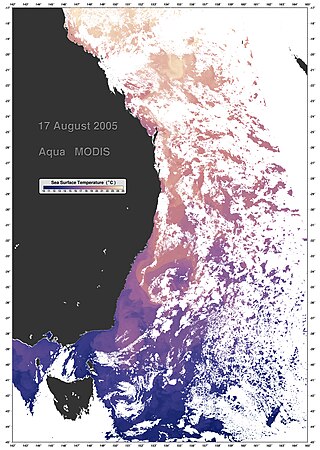
The East Australian Current (EAC) is a warm, southward, western boundary current that is formed from the South Equatorial Current (SEC) crossing the Coral Sea and reaching the eastern coast of Australia. At around 15° S near the Australian coast the SEC divides forming the southward flow of the EAC. It is the largest ocean current close to the shores of Australia.
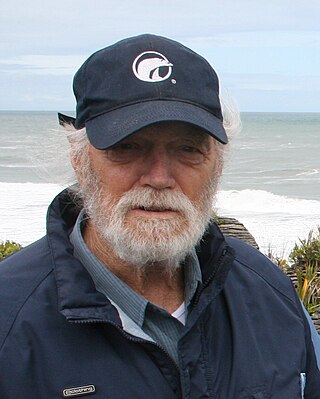
David McNiven Garner was notable as a published research physicist, with a focus in physical oceanography and ocean circulation.

Kina is a sea urchin endemic to New Zealand. This echinoderm belongs to the family Echinometridae and it can reach a maximum diameter of 16–17 cm.
Internal tides are generated as the surface tides move stratified water up and down sloping topography, which produces a wave in the ocean interior. So internal tides are internal waves at a tidal frequency. The other major source of internal waves is the wind which produces internal waves near the inertial frequency. When a small water parcel is displaced from its equilibrium position, it will return either downwards due to gravity or upwards due to buoyancy. The water parcel will overshoot its original equilibrium position and this disturbance will set off an internal gravity wave. Munk (1981) notes, "Gravity waves in the ocean's interior are as common as waves at the sea surface-perhaps even more so, for no one has ever reported an interior calm."
Adrian Edmund Gill FRS was an Australian meteorologist and oceanographer best known for his textbook Atmosphere-Ocean Dynamics. Gill was born in Melbourne Australia and worked at Cambridge, serving as Senior Research Fellow from 1963 to 1984. His father was Edmund Gill, geologist, palaeontologist and curator at the National Museum of Victoria.
North Pacific Intermediate Water (NPIW) is cold, moderately low salinity water mass that originates in the mixed water region (MWR) between the Kuroshio and Oyashio waters just east of Japan. Examination of NPIW at stations just east of the MWR indicates that the mixed waters in the MWR are the origin of the newest NPIW. The new NPIW ‘‘formed’’ in the MWR is a mixture of relatively fresh, recently ventilated Oyashio water coming from the subpolar gyre, and more saline, older Kuroshio water. The mixing process results in a salinity minimum and also in rejuvenation of the NPIW layer in the subtropical gyre due to the Oyashio input.
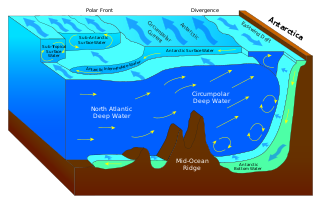
Mode water is defined as a particular type of water mass, which is nearly vertically homogeneous. Its vertical homogeneity is caused by the deep vertical convection in winter. The first term to describe this phenomenon is 18° water, which was used by Valentine Worthington to describe the isothermal layer in the northern Sargasso Sea cool to a temperature of about 18 °C each winter. Then Masuzawa introduced the subtropical mode water concept to describe the thick layer of temperature 16–18 °C in the northwestern North Pacific subtropical gyre, on the southern side of the Kuroshio Extension. The terminology mode water was extended to the thick near-surface layer north of the Subantarctic Front by McCartney, who identified and mapped the properties of the Subantarctic mode water (SAMW). After that, McCartney and Talley then applied the term subpolar mode water (SPMW) to the thick near-surface mixed layers in the North Atlantic’s subpolar gyre.

Trevor John McDougallFAGU is a physical oceanographer specialising in ocean mixing and the thermodynamics of seawater. He is Emeritus Scientia Professor of Ocean Physics in the School of Mathematics and Statistics at the University of New South Wales, Sydney, Australia, and is Past President of the International Association for the Physical Sciences of the Oceans (IAPSO) of the International Union of Geodesy and Geophysics.
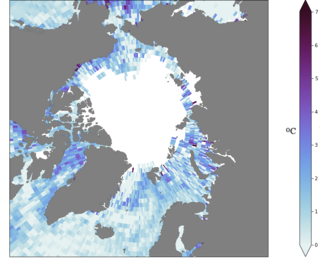
Atlantification is the increasing influence of Atlantic water in the Arctic. Warmer and saltier Atlantic water is extending its reach northward into the Arctic Ocean. The Arctic Ocean is becoming warmer and saltier and sea-ice is disappearing as a result. The process can be seen on the figure on the far right, where the sea surface temperature change in the past 50 years is shown, which is up to 5 degrees in some places. This change in the Arctic climate is most prominent in the Barents Sea, a shallow shelf sea north of Scandinavia, where sea-ice is disappearing faster than in any other Arctic region, impacting the local and global ecosystem.
Sarah Gille is a physical oceanographer at Scripps Institution of Oceanography known for her research on the role of the Southern Ocean in the global climate system.
Phyllis Jean Stabeno is a physical oceanographer known for her research on the movement of water in polar regions. She has led award-winning research projects in the Arctic and was noted for a distinguished scientific career by the National Oceanic and Atmospheric Administration.
LuAnn Thompson is the Walters Endowed Professor at the University of Washington. She is known for her work in modeling the movement of heat and chemicals via ocean currents.

Cold and dense water from the Nordic Seas is transported southwards as Faroe-Bank Channel overflow. This water flows from the Arctic Ocean into the North Atlantic through the Faroe-Bank Channel between the Faroe Islands and Scotland. The overflow transport is estimated to contribute to one-third of the total overflow over the Greenland-Scotland Ridge. The remaining two-third of overflow water passes through Denmark Strait, the Wyville Thomson Ridge (0.3 Sv), and the Iceland-Faroe Ridge (1.1 Sv).
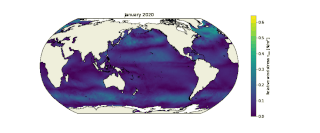
Relative wind stress is a shear stress that is produced by wind blowing over the surface of the ocean, or another large body of water. Relative wind stress is related to wind stress but takes the difference between the surface ocean current velocity and wind velocity into account. The units are Newton per meter squared or Pascal . Wind stress over the ocean is important as it is a major source of kinetic energy input to the ocean which in turn drives large scale ocean circulation. The use of relative wind stress instead of wind stress, where the ocean current is assumed to be stationary, reduces the stress felt over the ocean in models. This leads to a decrease in the calculation of power input into the ocean of 20–35% and thus, results in a different simulation of the large scale ocean circulation.
The Agulhas Leakage is an inflow of anomalously warm and saline water from the Indian Ocean into the South Atlantic due to the limited latitudinal extent of the African continent compared to the southern extension of the subtropical super gyre in the Indian Ocean. The process occurs during the retroflection of the Agulhas Current via shedding of anticyclonic Agulhas Rings, cyclonic eddies and direct inflow. The leakage contributes to the Atlantic Meridional Overturning Circulation (AMOC) by supplying its upper limb, which has direct climate implications.

The Lofoten Vortex, also called Lofoten Basin Vortex or Lofoten Basin Eddy, is a permanent oceanic anticyclonic eddy, located in the northern part of the Norwegian Sea, off the coast of the Lofoten archipelago. It was documented for the first time in the 1970s.

Irminger Rings (IRs) are mesoscale ocean eddies that are formed off the West coast of Greenland and travel southwestwards through the Labrador Sea. Most IRs are anti-cyclonic. There is considerable interest in researching IRs, because they have been hypothesized to influence deep convection in the Labrador sea, and therefore the formation of deep water.
References
- ↑ Denham, R. N.; Crook, F. G. (March 1976). "The Tasman front". New Zealand Journal of Marine and Freshwater Research. 10 (1): 15–30. doi: 10.1080/00288330.1976.9515596 . ISSN 0028-8330.
- 1 2 Andrews, John C.; Lawrence, Martin W.; Nilsson, Carl S. (November 1980). "Observations of the Tasman Front". Journal of Physical Oceanography. 10 (11): 1854–1869. Bibcode:1980JPO....10.1854A. doi: 10.1175/1520-0485(1980)010<1854:oottf>2.0.co;2 . ISSN 0022-3670.
- 1 2 Baird, Mark E.; Timko, Patrick G.; Middleton, Jason H.; Mullaney, Thomas J.; Cox, Deborah R.; Suthers, Iain M. (November 2008). "Biological properties across the Tasman Front off southeast Australia". Deep-Sea Research Part I: Oceanographic Research Papers. 55 (11): 1438–1455. Bibcode:2008DSRI...55.1438B. doi:10.1016/j.dsr.2008.06.011.
- ↑ Stanton, B. R. (September 1981). "An oceanographic survey of the Tasman Front". New Zealand Journal of Marine and Freshwater Research. 15 (3): 289–297. doi: 10.1080/00288330.1981.9515924 . ISSN 0028-8330.
- 1 2 Mulhearn, P. J. (August 1987). "The Tasman Front: A Study Using Satellite Infrared Imagery". Journal of Physical Oceanography. 17 (8): 1148–1155. Bibcode:1987JPO....17.1148M. doi: 10.1175/1520-0485(1987)017<1148:ttfasu>2.0.co;2 . ISSN 0022-3670.
- ↑ Roemmich, Dean; Sutton, Philip (1998-06-15). "The mean and variability of ocean circulation past northern New Zealand: Determining the representativeness of hydrographic climatologies". Journal of Geophysical Research: Oceans. 103 (C6): 13041–13054. Bibcode:1998JGR...10313041R. doi: 10.1029/98JC00583 . ISSN 2156-2202.
- 1 2 Stanton, B. R. (June 1979). "The tasman front". New Zealand Journal of Marine and Freshwater Research. 13 (2): 201–214. doi: 10.1080/00288330.1979.9515795 . ISSN 0028-8330.
- 1 2 Tilburg, Charles E.; Hurlburt, Harley E.; O'Brien, James J.; Shriver, Jay F. (October 2001). "The Dynamics of the East Australian Current System: The Tasman Front, the East Auckland Current, and the East Cape Current". Journal of Physical Oceanography. 31 (10): 2917–2943. Bibcode:2001JPO....31.2917T. doi: 10.1175/1520-0485(2001)031<2917:tdotea>2.0.co;2 . ISSN 0022-3670.
- ↑ Oke, Peter R.; Middleton, Jason H. (April 2001). "Nutrient enrichment off Port Stephens: the role of the East Australian Current". Continental Shelf Research. 21 (6–7): 587–606. Bibcode:2001CSR....21..587O. CiteSeerX 10.1.1.169.5222 . doi:10.1016/S0278-4343(00)00127-8.
- ↑ Grant, Katharine M.; Dickens, Gerald R. (November 2002). "Coupled productivity and carbon isotope records in the southwest Pacific Ocean during the late Miocene–early Pliocene biogenic bloom" (PDF). Palaeogeography, Palaeoclimatology, Palaeoecology. 187 (1–2): 61–82. Bibcode:2002PPP...187...61G. doi:10.1016/S0031-0182(02)00508-4. S2CID 128569245.
- ↑ Griffiths, F. B.; Wadley, V. A. (November 1986). "A synoptic comparison of fishes and crustaceans from a warm-core eddy, the East Australian Current, the Coral Sea and the Tasman Sea". Deep-Sea Research Part A: Oceanographic Research Papers. 33 (11): 1907–1922. Bibcode:1986DSRA...33.1907G. doi:10.1016/0198-0149(86)90085-3.